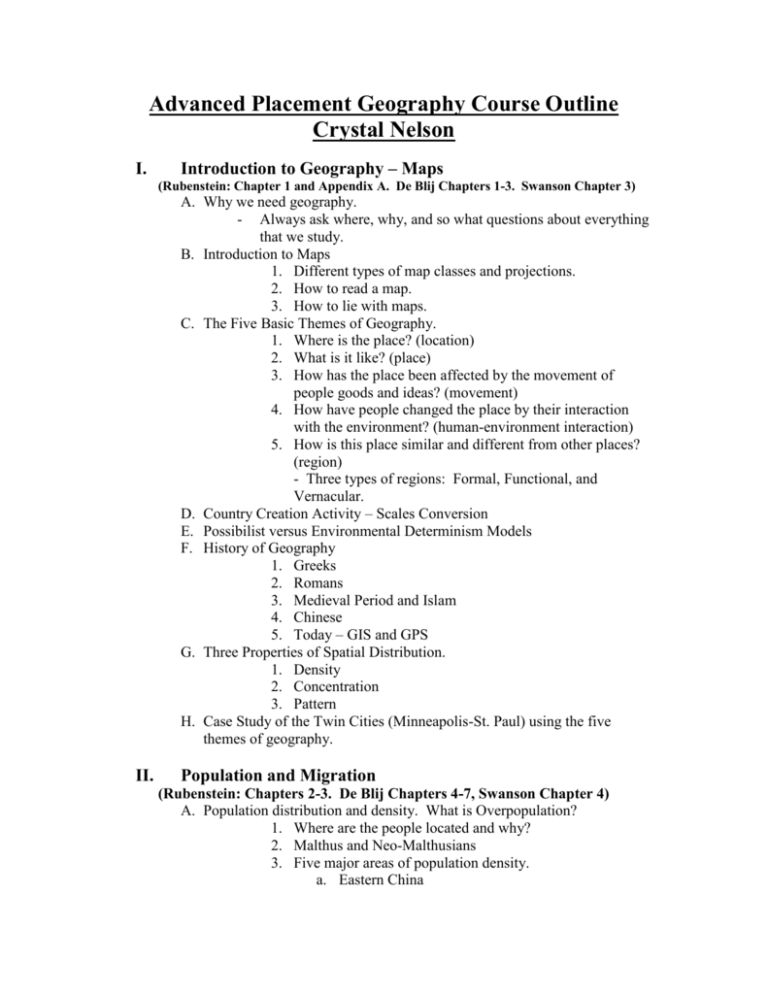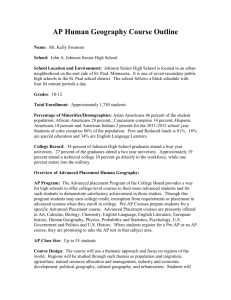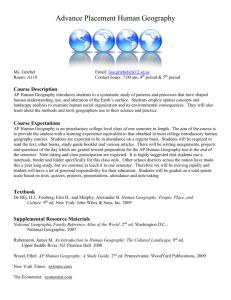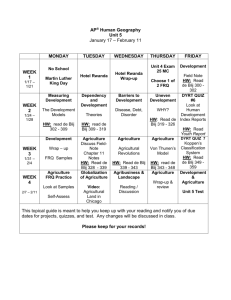Advanced Placement Geography Course Outline Crystal Nelson
advertisement

Advanced Placement Geography Course Outline Crystal Nelson I. Introduction to Geography – Maps (Rubenstein: Chapter 1 and Appendix A. De Blij Chapters 1-3. Swanson Chapter 3) A. Why we need geography. - Always ask where, why, and so what questions about everything that we study. B. Introduction to Maps 1. Different types of map classes and projections. 2. How to read a map. 3. How to lie with maps. C. The Five Basic Themes of Geography. 1. Where is the place? (location) 2. What is it like? (place) 3. How has the place been affected by the movement of people goods and ideas? (movement) 4. How have people changed the place by their interaction with the environment? (human-environment interaction) 5. How is this place similar and different from other places? (region) - Three types of regions: Formal, Functional, and Vernacular. D. Country Creation Activity – Scales Conversion E. Possibilist versus Environmental Determinism Models F. History of Geography 1. Greeks 2. Romans 3. Medieval Period and Islam 4. Chinese 5. Today – GIS and GPS G. Three Properties of Spatial Distribution. 1. Density 2. Concentration 3. Pattern H. Case Study of the Twin Cities (Minneapolis-St. Paul) using the five themes of geography. II. Population and Migration (Rubenstein: Chapters 2-3. De Blij Chapters 4-7, Swanson Chapter 4) A. Population distribution and density. What is Overpopulation? 1. Where are the people located and why? 2. Malthus and Neo-Malthusians 3. Five major areas of population density. a. Eastern China b. Northern and Coastal India c. Central and Western Europe d. Southeastern Asia e. Northeastern North America B. Population Structure. 1. Age, sex, profiles, and composition of the population. 2. Population Pyramids C. Demographic Transition Model 1. Family planning or lack of. 2. Reasons for high or low rates. Sub-Saharan Africa = high. Europe = low. 3. Stages and Development D. Historical Perspectives. 1. Population sizes of countries over time. China, United States, Great Britain, etc. 2. Reasons for increased population over time. a. Factors which contribute to increased population: -medical advances -increased food production -ethnicity or religious issues -economic issues b. Factors which contribute to decreased population: -famines or plagues -war or political turmoil -economic issues E. Immigration, Migration, and Refugees. 1. Case study of the United States. Where did the people come from? 2. Today. Where and Why? Kurds, Africa, East Asia 3. Hmong migration. 4. Push and Pull factors – economic, environmental and political. F. Population Equations and Scientific Methods 1. Balancing Equation. 2. Doubling time and halving time. 3. Crude Birth Rate and Crude Death Rate. 4. Dependency ratio. III. Agriculture and Society (Rubenstein Chapter 10. De Blij Chapters 14-16, Swanson Chapter 7) A. Historical geography of Agriculture. 1. Trends in United States Agriculture. a. Native American agriculture b. European settlement agriculture. c. Movement west due to agriculture. d. Western agriculture – lack of precipitation. 2. Movement from Hunting and Gathering to Planting and Sustaining. First Agricultural Revolution a. Slow transfer process. b. Movement was not a revolution but rather evolutionary. 3. Second Agricultural Revolution. a. Use of Machinery in agriculture. b. Increased productivity in agriculture. 4. Third Agricultural Revolution a. Increased industrialization of agriculture. b. Increased production – Green Revolution. 5. Three Primary Agricultural Hearths. a. Middle East. b. Southeast Asia into China and Southern India c. Southern Mexico and Northern South America. B. Agricultural regions and patterns of change. 1. Von Thunen’s model of agricultural land use. Does it still work? a. Land analysis of Minnesota and United States cropland in comparison to Von Thunen’s land use model. 2. What grows where in the United States and why? a. Rice – deep south and Hawaii b. Corn – Eastern Midwest. c. Wheat – Great Plains d. Tobacco – Middle Atlantic Regions e. Wine – California, Oregon f. Pineapple – Hawaii, California, Florida g. Barley – Midwest C. Creative Destruction – Removing what nature originally produced there in order to grow what is desired. Human modification of the Environment. Positive and negative. D. Different Types of Agricultural Systems 1. Plantation agriculture. 5. Truck farming 2. Shifting agriculture. 6. Slash-and-burn agriculture 3. Commercial farming. 7. Mediterranean agriculture 4. Subsistence farming. E. Agriculture Game – What grows where? F. Agricultural Land Use Patterns 1. Metes and Bounds 2. Township and Range 3. French Long Lot IV. Industry and Economic Development (Rubenstein Chapters 9 and 11. De Blij Chapter 21-24. Swanson Chapter 8) A. Site and Situation Factors. 1. Why did Pittsburgh and Detroit do so well? 2. What geographic factors contribute to a city’s economic success? B. Two view of Economic Development. 1. Optimistic Viewpoint – abundance of resources. 2. Pessimistic Viewpoint a. geography – distribution of resources does not match the demand. b. Market dependant c. Investment is concentrated in a few locations and is not universal. C. Weber’s Least Cost Theory 1. Bulk gaining Industries & bulk-reducing industries D. World Systems Theory – Use of World, Regional and Local Scales 1. Core Periphery Model. a. Industrial core region b. Upward Transition c. Downward Transition d. Resource Frontier 2. Core, Semi-core or semi-periphery and periphery. E. Basic Industry versus Non-basic Industry. 1. Basic – city forming. Minneapolis – milling, St. Paul – brewing 2. Non-basic – city serving. Fast food restaurants. 3. Multiplier Effect – focuses on the basic. F. Location of Industry 1. Agglomeration 2. Deglomeration G. Needs for Economic Development. 1. Environmental compatibility. 2. Political support. 3. Social acceptance. 4. Economic base of support a. worker training and experience b. capital investment in infrastructure H. Modernization of Industry Today. -The rise of the Sunbelt states. I. Transportation and Industrialization. Economic reasons for each of the transportation methods: Airplane, truck, train, pipeline, ships J. Causes or Lack of Development 1. Rostow’s Stages of Development 2. Nolan’s Stages of Growth Model. K. Measurement of Development 1. Key Indicators of Development – economic, social and demographic 2. Human Development Index 3. Physical Quality of Life Index L. New International Division of Labor (NIDL) V. Political Geography – Geopolitics (Rubenstein Chapters 7-8. De Blij Chapters 25-31. Swanson Chapter 6) A. Definition of a boundary. 1. Use of standard maps to outline political boundaries. 2. Learners map maps outlining new political boundaries. Difficulties in making new boundaries. a. Make maps according to latitude and longitude. b. Make maps according to natural features. c. Make maps according to cultural differences. 3. Need for Boundaries. 4. Boundary Disputes a. Definitional Boundary disputes b. Locational boundary disputes c. Operational boundary disputes d. Allocational boundary disputes B. Definition of a Nation 1. What differs a nation from a state. 2. Case studies: Basque, Kurds, Flemish, Hmong, Zulu, Ojibwa, Palestinians C. Sovereignty. 1. Who allows a nation to be sovereign? 2. Native American Sovereignty and rights. D. Geographic Colonialism. 1. European colonialism throughout the world. 2. Economic reasons – gain financially for the home country. 3. Moral reasons – save the unsaved. 4. Geopolitical reason – maintain power in Europe. 5. Meinig’s Three models for colonialism: a. Land Empire – Spain b. Sea Empire – Portugal c. Settler Empire – England E. The Five Shapes of Countries. Territorial Morphology. 1. Compact – Uruguay 2. Perforated – South Africa 3. Elongated – Chile 4. Prorupted – Thailand 5. Fragmented – Indonesia F. Political Organization of Space. 1. Activity for voting districts – gerrymandering. 2. Boundary disputes between states. United States and Canada. Iran and Iraq, China and India, Iraq and Kuwait. 3. Geography and War. G. Modern Geopolitical Theories. Risk game 1. Heartland Theory. Sir Halford MacKinder 2. Rimland Theory. Nicholas Spykman 3. Domino Theory. United States CIA. H. Supranational and Devolution 1. European Union 2. Balkanization I. Ethnicity and Race 1. Ethnic Landscapes 2. Acculturation and assimilation VI. Cultural Geography. (Rubenstein Chapters 4-6. De Blij Chapters 8-13. Swanson Chapter 5) A. Music and Geography. 1. Country music region 2. Bluegrass music region 3. Blues music region 4. Tex-Mex music region 5. Cajun music region 6. Polka music region 7. Mo-town music region B. Culture and Food. 1. Hot Dog Video. PBS 2. Good/Bad Food Guide video. Lonely Planet C. Folk versus Popular Culture 1. Music and Food - Regionalism 2. McDonald’s and KFC in China. 3. Sports – soccer 4. Architecture. D. Language. 1. What is language? a. Dialect with an army behind it? b. Development of languages. c. Evolution of language to a social content d. Language standardization. Official language 2. Language Groups of the World a. Language families. b. Origins and Diffusions of Languages. c. Distributions of major languages – Chinese, English, Spanish. d. Lingua franca – English and Swahili. Mandarin E. Religions. 1. Origins of Religions. a. Three of the world’s five major religions based in Jerusalem. – Christianity, Judaism, Islam, Buddhism and Hinduism – Eastern religions b. All societies have a belief system. 2. Spread of Religion. a. Universalizing religion – convert the unsaved – Christianity. b. Ethnic religion – does not actively pursue other people – Judaism. c. Polytheism versus monotheism. 3. Diffusion of Religion. a. Spread from Middle East and India b. Major religion groups today. 4. Religion and Conflict. a. Middle East – Israel/Palestine b. Sri Lanka – Hindu’s and Buddhism F. Cultural Landscapes Activity. 1. City park activity. Look for things that describe the culture of an area. 2. How can we tell what ethnic group lives where? - Art work and public places. VII. Urbanization. (Rubenstein Chapters 12-13. De Blij Chapters 17-20. Swanson Chapter 9) A. Defining urban. B. Development and evolution of urban communities 1. Early cities 2. Medieval cities 3. Colonial cities 4. Indigenous cities C. Models of urban land systems and Internal Structures of Cities. 1. Concentric zone theory. - Burgess 2. Sector Theory. - Hoyt 3. Multiple Nuclei Theory – Harris and Ulman. 4. Keno-capitalism Model – Dear and Flusty. 5. Gravity Model 6. Central Place Theory. Cristaller. D. Function of Cities. 1. Define urban function – offering services. 2. Classification by service offerings instead of by size. 3. Classification of urban areas: Hamlet, town, city, metropolis, megalopolis. 4. Primate cities. E. Hinterland. Central Place Theory. 1. Economic reach 2. Centrality 3. Range 4. Threshold F. Structure of World Cities 1. Eastern United States Cities 2. Western United States Cities 3. Latin American Cities – Ford Model 4. European Cities 5. African Cities 6. Islamic Cities 7. Southeast Asian Cities G. Built Environment and Social Space. 1. Central Business District 2. Suburbanization 3. Urban realms H. Problems of Urban Areas: Crime, pollution, traffic congestion, housing costs, race relations, water usage I. Response to Urban Growth. 1. Smart Growth – Gentrification. 2. Met Council in Minneapolis/St. Paul VIII. Preparation for Final Examination (AP Exam Tuesday May 13th) The following unit will follow AFTER the AP Exam: IX. Land Use Management and Natural Resource Allocation. (Rubenstein Chapter14. De Blij Chapters 32-35) A. Where are the resources located in the United States? 1. Coal regions – Appalachian and western areas. 2. Gold regions – West – South Dakota 3. Iron Ore – Minnesota and Michigan 4. Forest Products – Great North Woods, Southeast and Northwest. 5. Fishing – New England and Pacific Northwest 6. Oil – Alaska and Gulf states. B. Why are these resources important to the United States? 1. Economic Base. Employment and money. 2. Provides raw materials for industry. C. Case Study – Topographic Map activity of Tennessee. 1. Four Land Use Decision Making Models: a. Economic – money and development b. Sustainability – use but not abuse c. Environmental – parks d. Preservationist – don’t touch D. Other Sources of Energy in the United States Today. Nuclear, geothermal, solar, hydroelectric, biomass, wind E. Pollution and Human Impacts 1. Acid Rain 2. Greenhouse gases 3. Global Warming/Climate Change debate









